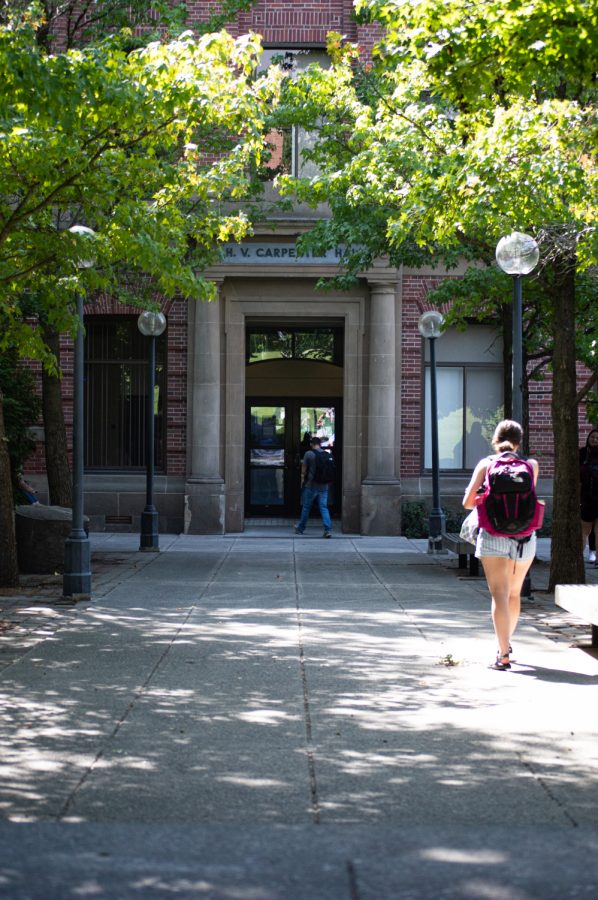Habitat for Humanity, WSU partnership aims to build energy-efficient housing
Materials, techniques are experimental; final wall of house was raised Sept. 2
Students are heading to class at the School of Design and Construction in Carpenter Hall.
September 7, 2021
WSU’s School of Design and Construction is partnering with Palouse Habitat for Humanity to research energy-efficient affordable housing.
Habitat for Humanity’s goal is to provide housing for low- to moderate-income families who need help with shelter. Those interested have to fill out and submit an application that is about eight pages long, said Jennifer Wallace, executive director of Palouse Habitat for Humanity.
If selected, the person gets sweat equity, meaning they have to put hundreds of hours of work into building the home. In return, they get a zero-interest mortgage. This saves them about $100,000, Wallace said.
Local volunteers do all the work with help from licensed plumbers and electricians, she said. Building days are on Thursdays and Saturdays for about 8 hours each day.
Each three-bedroom, two-bath house costs about $170,000 to produce. This money mainly comes from donations and Habitat for Humanity’s thrift store that sells home improvement items, repair materials and furniture.
The School of Design and Construction partnered with Habitat for Humanity to create a Housing Energy Affordability Lab house to see how they could make an energy-efficient house that is affordable, said Ryan Smith, School of Design and Construction director.
“As a research institution and a land ground outreach institution, we very much want to ask the question, ‘How can you make an affordable home, but also have it be high performing or energy-efficient?’” Smith said.
In this research, the team is looking at embodied energy or carbon, which goes into the house while building it. They are also observing operational energy, which is the energy used during the operation, he said.
To limit energy use, they use tactics like “fabric first.” The goal is to put as much material into the roof, foundation and outside walls so the house is resistant to the transfer of heat or cooling. Getting high-performing windows during this time is also a huge goal. Smith said the HEAL house is getting about 40 percent more insulation than a typical home.
They are also building the house with no ducts. If the ducts are not sealed correctly, a lot of excess air can get out. A mini-split will be used to blow heat or cool air into the home, he said.
All the materials and techniques being implemented in the HEAL house are experiments, Smith said.
There are two main goals with the HEAL house. The first goal is to figure out how much it costs to make these environmentally-friendly changes. The second goal is to see if Habitat for Humanity volunteers are capable of putting the energy-efficient materials into the home, he said.
School of Design and Construction students have been extremely involved in this project, Smith said. The students went through all the materials WSU had, categorized them into a spreadsheet and then reverse-engineered them into the house. This means the house is designed around the materials when it is typically the opposite.
WSU’s Center for Civic Engagement also has regular build days where any student can come and help build a house, Wallace said.
“There’s a lot of ways to be involved that don’t necessarily involve swinging a hammer,” Wallace said.
Habitat for Humanity needs volunteers at its store, in marketing and communications and for event planning, she said.
Volunteers raised the last HEAL house wall Sept. 2. The monitoring equipment will probably be placed in the home between late September and early October. They hope to finish the HEAL house in the spring, Smith said.









